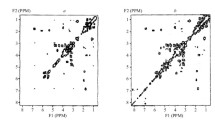Summary
Bacterially fermented mistletoe preparations (BFMP) were tested on rat hepatoma tissue culture (HTC) cells and human leukemia Molt 4 cells. A dose-dependent inhibition of the growth rate of the cells was observed. For both cell lines, cytostatic concentrations, expressed in weight of fresh plant, were 0.5 mg/ml culture medium for oak BFMP and 1 mg/ml for apple tree BFMP. However, the action of the two preparations was markedly different on each cell line. Non-viable HTC cells were not stained by trypan blue while non-viable Molt 4 cells were fully colored by this reagent. A lysis of cellular membranes of HTC cells was observed by electron microscopy. Furthermore, oak BFMP inhibited the growth of virus transformed 3T3-SV40 cells more than that of non-transformed 3T3 cells. In contrast to BFMP, non-fermented extracts and a purified mistletoe lectin showed a greater inhibition of the growth of Molt 4 cells than of HTC cells. Samples withdrawn at different times during fermentation gradually lost their inhibitory effect on the growth of Molt 4 cells while their action on HTC cells increased up to the 4th day of fermentation. These results are discussed in relation to the cytotoxic substances of mistletoe already characterized.
Similar content being viewed by others
References
Khwaja, T. A., Dias, C. B., and Pentecost, S., Experimental basis for the use of ‘Iscador’ in cancer treatment. 13th International Congress of Chemotherapy, Vienna 1983.
Sallé, G., Effets d'un extrait de gui (Viscum album L.) sur la croissance des racines de lentilles (Lens culinaris L.). I. Effets physiologiques. Planta Medica38 (1980) 43.
Baudino, S., Etude de l'action d'extraits de gui (Viscum album L.) sur différents systèmes expérimentaux, thèse de l'université Pierre et Marie Curie. Paris 1985.
Bloksma, N., van Dijk, H., Korst, P., and Willers, J. M., Immunobiology156 (1979) 309.
Bloksma, N., Schiermann, P., de Reuver, M., van Dijk, H., and Willers, J. M., Planta med.46 (1982) 1.
Rentea, R., Lyon, E., and Hunter, R., Lab. Invest.44 (1981) 43.
Franz, H., Pharmazie40 (1985) 97.
Luther, P., Lektin and Toxin der Mistel. Akademie-Verlag, Berlin 1982.
Franz, H., Ziska, P., and Kindt, A., Biochem. J.195 (1981) 481.
Stirpe, F., Sandvig, K., Olsnes, S., and Pihl, A., J. biol. Chem.257 (1982) 13271.
Samuelsson, G., and Petterson, B., Acta chem. scand.24 (1970) 2751.
Konopa, J., Woynarowski, J. M., and Lewandowska-Gumieniak, M., Hoppe-Seyler's Z. physiol. Chem.361 (1980) 1525.
Vester, F., Bohne, L., and El-Fouly, M., Hoppe-Seyler's Z. physiol. Chem.349 (1968) 495.
Nienhaus, J., Stoll, M., and Vester, F., Experientia26 (1970) 524.
Snajberk, G., Die kanzerostatischen Wirkungen spezieller Viscumprotein—Signifikanz und Wirkungsverluste. Diss. Univ. Munich 1980.
Jordan, E., Chemische und immunologische Untersuchungen von Polysacchariden und anderen hochmolekularen Inhaltsstoffen ausViscum album (L.). Diss. Univ. Munich 1985.
Ziska, P., and Franz, H., Determination of lectin content in commercial mistletoe preparations for cancer therapy using the ELISA technique, in: Lectins, vol. 4, Eds T. C. Bøg-Hansen and J. Breborowicz. Walter de Gruyter, Berlin/New York, in press (1985).
Samuelsson, G., Syst. Zool.22 (1974) 566.
Olsnes, S., Stirpe, F., Sandvig, K., and Pihl, A., J. biol. Chem.257 (1982) 13263.
Tompson, E. B., Tomkins, G. M., and Curran, J. F., Proc. natn. Acad. Sci.56 (1966) 296.
Phillips, H. J., and Terryberry, J. E., Expl Cell Res.13 (1957) 341.
Minowada, J., Ohnuma, T., and Morre, G. E., J. natn. Cancer Inst.49 (1972) 891.
Holley, R. W., and Kiernan, J. A., Proc. natn. Acad. Sci.60 (1968) 300.
Todaro, G. J., and Green, H., Virology23 (1964) 117.
Reynolds, E. S., J. Cell Biol.17 (1963) 208.
Cohen, A. L., and Garner, G. E., Proc. 29th A. Meet. Electron Microsc. Soc. Am. (1971) 450.
Klamerth, O., Vester, F., and Kelner, G., Hoppe-Seyler's Z. physiol. Chem.349 (1968) 863.
Vester, F., Schweiger, A., Seel, A., and Stoll, M., Hoppe-Seyler's Z. physiol. Chem.349 (1968) 865.
Vester, F., Krebsgeschehen5 (1977) 106.
Author information
Authors and Affiliations
Additional information
The bacterially fermented mistletoe preparations, named BFMP in the text, were obtained from the Hiscia Institute, CH-4144 Arlesheim, Switzerland, under the name of Iscador. For oak BFMP, mistletoe was fromQuercus petraea Liebl. andQuercus robur L.; for apple tree BFMP fromMalus domestica Borkh.
Rights and permissions
About this article
Cite this article
Ribéreau-Gayon, G., Jung, M.L., Baudino, S. et al. Effects of mistletoe (Viscum album L.) extracts on cultured tumor cells. Experientia 42, 594–599 (1986). https://doi.org/10.1007/BF01955552
Published:
Issue Date:
DOI: https://doi.org/10.1007/BF01955552



